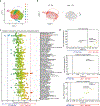CD4+ T cell immunity is dependent on an intrinsic stem-like program
- PMID: 38168955
- PMCID: PMC11064861
- DOI: 10.1038/s41590-023-01682-z
CD4+ T cell immunity is dependent on an intrinsic stem-like program
Abstract
CD4+ T cells are central to various immune responses, but the molecular programs that drive and maintain CD4+ T cell immunity are not entirely clear. Here we identify a stem-like program that governs the CD4+ T cell response in transplantation models. Single-cell-transcriptomic analysis revealed that naive alloantigen-specific CD4+ T cells develop into TCF1hi effector precursor (TEP) cells and TCF1-CXCR6+ effectors in transplant recipients. The TCF1-CXCR6+CD4+ effectors lose proliferation capacity and do not reject allografts upon adoptive transfer into secondary hosts. By contrast, the TCF1hiCD4+ TEP cells have dual features of self-renewal and effector differentiation potential, and allograft rejection depends on continuous replenishment of TCF1-CXCR6+ effectors from TCF1hiCD4+ TEP cells. Mechanistically, TCF1 sustains the CD4+ TEP cell population, whereas the transcription factor IRF4 and the glycolytic enzyme LDHA govern the effector differentiation potential of CD4+ TEP cells. Deletion of IRF4 or LDHA in T cells induces transplant acceptance. These findings unravel a stem-like program that controls the self-renewal capacity and effector differentiation potential of CD4+ TEP cells and have implications for T cell-related immunotherapies.
© 2024. The Author(s), under exclusive licence to Springer Nature America, Inc.
Figures
















References
-
- Ruterbusch M, Pruner KB, Shehata L & Pepper M In vivo CD4(+) T cell differentiation and function: revisiting the Th1/Th2 paradigm. Annu. Rev. Immunol. 38, 705–725 (2020). - PubMed
MeSH terms
Grants and funding
LinkOut - more resources
Full Text Sources
Molecular Biology Databases
Research Materials
Miscellaneous

